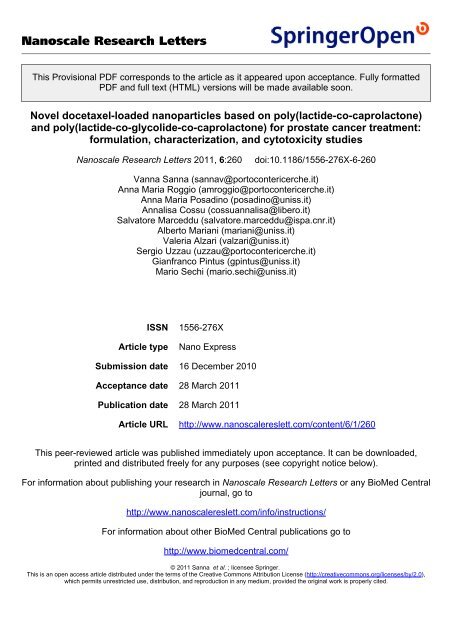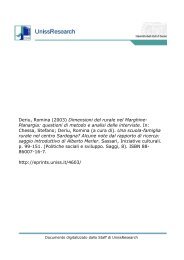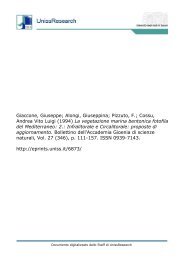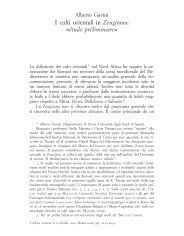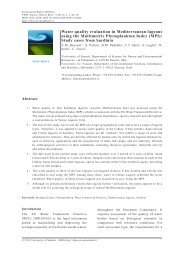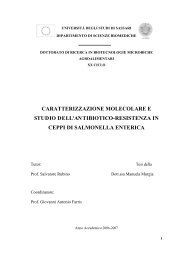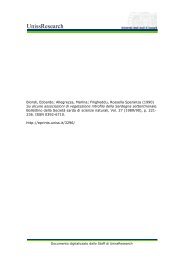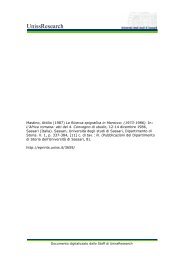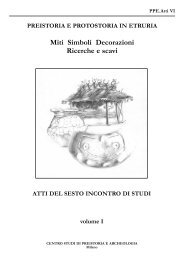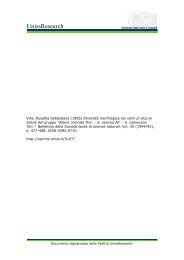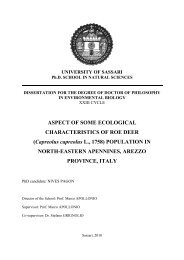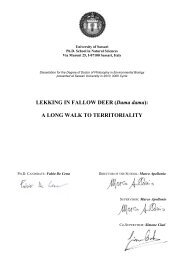Novel docetaxel-loaded nanoparticles based on poly(lactide-co ...
Novel docetaxel-loaded nanoparticles based on poly(lactide-co ...
Novel docetaxel-loaded nanoparticles based on poly(lactide-co ...
You also want an ePaper? Increase the reach of your titles
YUMPU automatically turns print PDFs into web optimized ePapers that Google loves.
Nanoscale Research Letters<br />
This Provisi<strong>on</strong>al PDF <strong>co</strong>rresp<strong>on</strong>ds to the article as it appeared up<strong>on</strong> acceptance. Fully formatted<br />
PDF and full text (HTML) versi<strong>on</strong>s will be made available so<strong>on</strong>.<br />
<str<strong>on</strong>g>Novel</str<strong>on</strong>g> <str<strong>on</strong>g>docetaxel</str<strong>on</strong>g>-<str<strong>on</strong>g>loaded</str<strong>on</strong>g> <str<strong>on</strong>g>nanoparticles</str<strong>on</strong>g> <str<strong>on</strong>g>based</str<strong>on</strong>g> <strong>on</strong> <strong>poly</strong>(<strong>lactide</strong>-<strong>co</strong>-caprolact<strong>on</strong>e)<br />
and <strong>poly</strong>(<strong>lactide</strong>-<strong>co</strong>-gly<strong>co</strong>lide-<strong>co</strong>-caprolact<strong>on</strong>e) for prostate cancer treatment:<br />
formulati<strong>on</strong>, characterizati<strong>on</strong>, and cytotoxicity studies<br />
Nanoscale Research Letters 2011, 6:260 doi:10.1186/1556-276X-6-260<br />
Vanna Sanna (sannav@portoc<strong>on</strong>tericerche.it)<br />
Anna Maria Roggio (amroggio@portoc<strong>on</strong>tericerche.it)<br />
Anna Maria Posadino (posadino@uniss.it)<br />
Annalisa Cossu (<strong>co</strong>ssuannalisa@libero.it)<br />
Salvatore Marceddu (salvatore.marceddu@ispa.cnr.it)<br />
Alberto Mariani (mariani@uniss.it)<br />
Valeria Alzari (valzari@uniss.it)<br />
Sergio Uzzau (uzzau@portoc<strong>on</strong>tericerche.it)<br />
Gianfran<strong>co</strong> Pintus (gpintus@uniss.it)<br />
Mario Sechi (mario.sechi@uniss.it)<br />
ISSN 1556-276X<br />
Article type Nano Express<br />
Submissi<strong>on</strong> date 16 December 2010<br />
Acceptance date 28 March 2011<br />
Publicati<strong>on</strong> date 28 March 2011<br />
Article URL http://www.nanoscalereslett.<strong>co</strong>m/c<strong>on</strong>tent/6/1/260<br />
This peer-reviewed article was published immediately up<strong>on</strong> acceptance. It can be down<str<strong>on</strong>g>loaded</str<strong>on</strong>g>,<br />
printed and distributed freely for any purposes (see <strong>co</strong>pyright notice below).<br />
For informati<strong>on</strong> about publishing your research in Nanoscale Research Letters or any BioMed Central<br />
journal, go to<br />
http://www.nanoscalereslett.<strong>co</strong>m/info/instructi<strong>on</strong>s/<br />
For informati<strong>on</strong> about other BioMed Central publicati<strong>on</strong>s go to<br />
http://www.biomedcentral.<strong>co</strong>m/<br />
© 2011 Sanna et al. ; licensee Springer.<br />
This is an open access article distributed under the terms of the Creative Comm<strong>on</strong>s Attributi<strong>on</strong> License (http://creative<strong>co</strong>mm<strong>on</strong>s.org/licenses/by/2.0),<br />
which permits unrestricted use, distributi<strong>on</strong>, and reproducti<strong>on</strong> in any medium, provided the original work is properly cited.
<str<strong>on</strong>g>Novel</str<strong>on</strong>g> <str<strong>on</strong>g>docetaxel</str<strong>on</strong>g>-<str<strong>on</strong>g>loaded</str<strong>on</strong>g> <str<strong>on</strong>g>nanoparticles</str<strong>on</strong>g> <str<strong>on</strong>g>based</str<strong>on</strong>g> <strong>on</strong> <strong>poly</strong>(<strong>lactide</strong>-<strong>co</strong>-caprolact<strong>on</strong>e) and <strong>poly</strong>(<strong>lactide</strong>-<br />
<strong>co</strong>-gly<strong>co</strong>lide-<strong>co</strong>-caprolact<strong>on</strong>e) for prostate cancer treatment: formulati<strong>on</strong>, characterizati<strong>on</strong>,<br />
and cytotoxicity studies<br />
Vanna Sanna* †1 , Anna Maria Roggio †1 , Anna Maria Posadino 2 , Annalisa Cossu 2 , Salvatore<br />
Marceddu 3 , Alberto Mariani 4 , Valeria Alzari 4 , Sergio Uzzau 1, 2 , Gianfran<strong>co</strong> Pintus 2 , and Mario<br />
Sechi 5<br />
1 Porto C<strong>on</strong>te Ricerche, Località Tramariglio, Alghero, Sassari 07041, Italy<br />
2 Department of Biomedical Sciences, Centre of Excellence for Biotechnology Development and Biodiversity<br />
Research, University of Sassari, Viale San Pietro 43/B, Sassari 07100, Italy<br />
3 Istituto di Scienze delle Produzi<strong>on</strong>i Alimentari (ISPA), CNR, Via dei Mille 48, Sassari 07100, Italy<br />
4 Department of Chemistry and local INSTM unit, University of Sassari, Via Vienna 2, Sassari 07100, Italy<br />
5 Dipartimento Farma<strong>co</strong> Chimi<strong>co</strong> Tossi<strong>co</strong>logi<strong>co</strong>, University of Sassari, Via Mur<strong>on</strong>i 23/A, Sassari 07100, Italy<br />
*Corresp<strong>on</strong>ding author: sannav@portoc<strong>on</strong>tericerche.it<br />
† Authors Vanna Sanna and Anna Maria Roggio c<strong>on</strong>tributed equally to this work.<br />
Email addresses:<br />
VS: sannav@portoc<strong>on</strong>tericerche.it<br />
AMR: amroggio@portoc<strong>on</strong>tericerche.it<br />
AMP: posadino@uniss.it<br />
AC: <strong>co</strong>ssuannalisa@libero.it<br />
SM: salvatore.marceddu@ispa.cnr.it<br />
AM: mariani@uniss.it<br />
1
VA: valzari@uniss.it<br />
SU: uzzau@portoc<strong>on</strong>tericerche.it<br />
GP: gpintus@uniss.it<br />
MS: mario.sechi@uniss.it<br />
Abstract<br />
Docetaxel (Dtx) chemotherapy is the opti<strong>on</strong>al treatment in patients with horm<strong>on</strong>e-refractory<br />
metastatic prostate cancer, and Dtx-<str<strong>on</strong>g>loaded</str<strong>on</strong>g> <strong>poly</strong>meric <str<strong>on</strong>g>nanoparticles</str<strong>on</strong>g> (NPs) have the potential to<br />
induce durable clinical resp<strong>on</strong>ses. However, alternative formulati<strong>on</strong>s are needed to over<strong>co</strong>me the<br />
serious side effects, also due to the adjuvant used, and to improve the clinical efficacy of the drug.<br />
In the present study, two novel biodegradable block-<strong>co</strong><strong>poly</strong>mers, <strong>poly</strong>(<strong>lactide</strong>-<strong>co</strong>-caprolact<strong>on</strong>e)<br />
(PLA-PCL) and <strong>poly</strong>(<strong>lactide</strong>-<strong>co</strong>-caprolact<strong>on</strong>e-<strong>co</strong>-gly<strong>co</strong>lide) (PLGA-PCL), were explored for the<br />
formulati<strong>on</strong> of Dtx-<str<strong>on</strong>g>loaded</str<strong>on</strong>g> NPs and <strong>co</strong>mpared with PLA- and PLGA-NPs. The nanosystems were<br />
prepared by an original nanoprecipitati<strong>on</strong> method, using Plur<strong>on</strong>ic F-127 as surfactant agent, and<br />
were characterized in terms of morphology, size distributi<strong>on</strong>, encapsulati<strong>on</strong> efficiency, crystalline<br />
structure, and in vitro release. To evaluate the potential anticancer efficacy of a nanoparticulate<br />
system, in vitro cytotoxicity studies <strong>on</strong> human prostate cancer cell line (PC3) were carried out. NPs<br />
were found to be of spherical shape with an average diameter in the range of 100 to 200 nm and a<br />
unimodal particle size distributi<strong>on</strong>. Dtx was in<strong>co</strong>rporated into the PLGA-PCL NPs with higher<br />
(p < 0.05) encapsulati<strong>on</strong> efficiency than that of other <strong>poly</strong>mers. Differential scanning calorimetry<br />
suggested that Dtx was molecularly dispersed in the <strong>poly</strong>meric matrices. In vitro drug release study<br />
showed that release profiles of Dtx varied <strong>on</strong> the bases of characteristics of <strong>poly</strong>mers used for<br />
formulati<strong>on</strong>. PLA-PCL and PLGA-PCL drug <str<strong>on</strong>g>loaded</str<strong>on</strong>g> NPs shared an overlapping release profiles,<br />
and are able to release about 90% of drug within 6 h, when <strong>co</strong>mpared with PLA- and PLGA-NPs.<br />
Moreover, cytotoxicity studies dem<strong>on</strong>strated advantages of the Dtx-<str<strong>on</strong>g>loaded</str<strong>on</strong>g> PLGA-PCL NPs over<br />
2
pure Dtx in both time- and c<strong>on</strong>centrati<strong>on</strong>-dependent manner. In particular, an increase of 20% of<br />
PC3 growth inhibiti<strong>on</strong> was determined by PLGA-PCL NPs with respect to free drug after 72 h<br />
incubati<strong>on</strong> and at all tested Dtx c<strong>on</strong>centrati<strong>on</strong>. In summary, PLGA-PCL <strong>co</strong><strong>poly</strong>mer may be<br />
c<strong>on</strong>sidered as an attractive and promising <strong>poly</strong>meric material for the formulati<strong>on</strong> of Dtx NPs as<br />
delivery system for prostate cancer treatment, and can also be pursued as a validated system in a<br />
more large c<strong>on</strong>text.<br />
Introducti<strong>on</strong><br />
Prostate cancer (PCa) is the most <strong>co</strong>mm<strong>on</strong> male malignancy and the sec<strong>on</strong>d leading cause of cancer<br />
death in Western industrialized <strong>co</strong>untries [1]. The PCa progressi<strong>on</strong> does not <strong>on</strong>ly mean distant<br />
metastases but also development of horm<strong>on</strong>e independence of its cells [2].<br />
Docetaxel (Dtx)-<str<strong>on</strong>g>based</str<strong>on</strong>g> regimen is re<strong>co</strong>mmended as opti<strong>on</strong>al treatment in patients with horm<strong>on</strong>e-<br />
refractory metastatic PCa, showing effective <strong>on</strong> locally advanced PCa and increasing overall<br />
survival [3]. Despite the recently reported promising out<strong>co</strong>me of Dtx, this drug is associated with<br />
systemic toxicity that limits the dose and durati<strong>on</strong> of therapy, particularly in elderly patients.<br />
Adverse effects of Dtx treatment include hypersensitivity reacti<strong>on</strong>s, b<strong>on</strong>e marrow suppressi<strong>on</strong>,<br />
cutaneous reacti<strong>on</strong>s, fluid retenti<strong>on</strong>, peripheral neuropathy, alopecia, cardiac disorders, and<br />
tiredness [4]. Moreover, to facilitate its clinical use, the Dtx poor water solubility requires a specific<br />
solvent system, such as ethanol/Tween 80 soluti<strong>on</strong>, which causes hypersensitivity reacti<strong>on</strong>, reduced<br />
uptake by tumor tissue and increased exposure to other body <strong>co</strong>mpartments [5].<br />
Therefore, alternative Dtx formulati<strong>on</strong>s are needed and <str<strong>on</strong>g>nanoparticles</str<strong>on</strong>g> (NPs)-<str<strong>on</strong>g>based</str<strong>on</strong>g> drug delivery<br />
systems are of special interest in addressing the major side effects of anticancer drug.<br />
Recently, a number of <strong>poly</strong>mers have been investigated for formulating biodegradable Dtx-<str<strong>on</strong>g>loaded</str<strong>on</strong>g><br />
NPs for cancer chemotherapy. The most widely used class of bio<strong>co</strong>mpatible and biodegradable<br />
<strong>poly</strong>mers, approved by Food and Drug Administrati<strong>on</strong> (FDA), is that of aliphatic <strong>poly</strong>esters,<br />
including <strong>poly</strong>(lactic acid) (PLA), <strong>poly</strong>(gly<strong>co</strong>lic acid) (PLGA), and their <strong>co</strong><strong>poly</strong>mers [6].<br />
3
However, these <strong>poly</strong>mers are characterized by a high hydrophobicity and slow degradati<strong>on</strong> rate that<br />
can represent in some cases a disadvantage for their use as drug carriers [7].<br />
In the family of <strong>poly</strong>esters, <strong>poly</strong>caprolact<strong>on</strong>e (PCL) shows an excellent bio<strong>co</strong>mpatibility and rapid<br />
degradability, good miscibility with a variety of <strong>poly</strong>mers and great permeability, which make it a<br />
suitable candidate for drug carrier [8].<br />
The methods for the preparati<strong>on</strong> of NPs from the preformed <strong>poly</strong>mers include nanoprecipitati<strong>on</strong>,<br />
emulsificati<strong>on</strong>/solvent evaporati<strong>on</strong>, emulsificati<strong>on</strong>/solvent diffusi<strong>on</strong>, and salting out [9]. As for the<br />
nanoprecipitati<strong>on</strong>, the particle formati<strong>on</strong> is <str<strong>on</strong>g>based</str<strong>on</strong>g> <strong>on</strong> precipitati<strong>on</strong> and subsequent solidificati<strong>on</strong> of<br />
the <strong>poly</strong>mer at the interface between a solvent and a n<strong>on</strong>-solvent [10]. Usually, surfactants or<br />
stabilizers are included in the process to modify the size and the surface properties, and to ensure<br />
the stability of the NP dispersi<strong>on</strong> [9]. The most popular stabilizer for the producti<strong>on</strong> of PLGA-<str<strong>on</strong>g>based</str<strong>on</strong>g><br />
NPs is <strong>poly</strong>(vinyl al<strong>co</strong>hol) (PVA). However, it has been found that residual PVA, which is very<br />
difficult to remove from the particles’ surface, causes relatively lower cellular uptake, thus resulting<br />
not satisfactorily bio<strong>co</strong>mpatible for the human body [11]. Therefore, other surfactants <strong>co</strong>uld be<br />
c<strong>on</strong>sidered as valuable alternatives to PVA. Poloxamer, a block <strong>co</strong><strong>poly</strong>mer of <strong>poly</strong>(ethylene oxide)–<br />
<strong>poly</strong>(propylene oxide)–<strong>poly</strong>(ethylene oxide), <strong>co</strong>mmercially known as Plur<strong>on</strong>ic, is another promising<br />
surface active agent approved by FDA for clinical use [12]. Additi<strong>on</strong>ally, several evidence<br />
dem<strong>on</strong>strated that poloxamers interact with multidrug-resistant tumors, resulting in a drastic<br />
sensitizati<strong>on</strong> of these tumors with respect to various anticancer agents [13, 14].<br />
The present work is aimed at investigating the influence of two previously unexplored<br />
biodegradable block-<strong>co</strong><strong>poly</strong>mers, such as <strong>poly</strong>(D,L-<strong>lactide</strong>-<strong>co</strong>-caprolact<strong>on</strong>e) (PLA-PCL) and <strong>poly</strong>(L-<br />
<strong>lactide</strong>-<strong>co</strong>-caprolact<strong>on</strong>e-<strong>co</strong>-gly<strong>co</strong>lide) (PLGA-PCL), <strong>on</strong> the physi<strong>co</strong>chemical and pharmaceutical<br />
properties of novel Dtx-<str<strong>on</strong>g>loaded</str<strong>on</strong>g> NPs, using PLA- and PLGA-NPs as <strong>co</strong>mparis<strong>on</strong>. The designed<br />
nanosystems were obtained by a modified nanoprecipitati<strong>on</strong> technique, using Plur<strong>on</strong>ic F-127<br />
instead of PVA as stabilizing agent. The NPs were characterized in terms of morphology,<br />
encapsulati<strong>on</strong> efficiency and crystalline structure, and in vitro release kinetics. Moreover, the<br />
4
antiproliferative efficacy of the most promising nanoparticulate prototype was assessed by in vitro<br />
cytotoxicity assay toward a human prostate cancer cell line (PC3).<br />
Materials and methods<br />
Materials<br />
Poly(D,L-<strong>lactide</strong>) (PLA) (inherent vis<strong>co</strong>sity 0.55 to 0.75 dl/g in chloroform), <strong>poly</strong>(D,L-<strong>lactide</strong>-<strong>co</strong>-<br />
gly<strong>co</strong>lide) (PLGA) (<strong>lactide</strong>:gly<strong>co</strong>lide 50:50 molar ratio, inherent vis<strong>co</strong>sity 0.55 to 0.75 dl/g in<br />
hexafluoroisopropanol) with esters end groups were purchased from Lactel Absorbable Polymers<br />
(Pelham, AL, USA). Poly(L-<strong>lactide</strong>-<strong>co</strong>-caprolact<strong>on</strong>e-<strong>co</strong>-gly<strong>co</strong>lide) (PLGA-PCL) (L-<br />
<strong>lactide</strong>:gly<strong>co</strong>lide:caprolact<strong>on</strong>e 70:10:20 molar ratio, inherent vis<strong>co</strong>sity 1.30 dl/g, in chloroform) was<br />
obtained from Sigma-Aldrich (Steinheim, Germany). Poly(L-<strong>lactide</strong>-<strong>co</strong>-caprolact<strong>on</strong>e) (PLA-PCL)<br />
(<strong>lactide</strong>:caprolact<strong>on</strong>e 70:30 molar ratio) was kindly provided from Purac Biomaterials (Gorinchen,<br />
Netherlands). Plur<strong>on</strong>ic ® F-127 was obtained from Sigma-Aldrich (Steinheim, Germany). Docetaxel<br />
(purity 99%) was supplied by ChemieTek (Indianapolis, IN, USA). All other chemicals were<br />
analytical grade and were used without further purificati<strong>on</strong>.<br />
Formulati<strong>on</strong> of <str<strong>on</strong>g>nanoparticles</str<strong>on</strong>g><br />
Drug-<str<strong>on</strong>g>loaded</str<strong>on</strong>g> NPs were prepared by a novel nanoprecipitati<strong>on</strong> method. Briefly, about 100 mg of<br />
<strong>poly</strong>mer and drug (1%, w/w) were dissolved in 6 ml of acet<strong>on</strong>itrile. The organic soluti<strong>on</strong> was then<br />
added dropwise under stirring to an aqueous soluti<strong>on</strong> of Plur<strong>on</strong>ic F-127 (1% w/v, 30 ml). The milky<br />
<strong>co</strong>lloidal suspensi<strong>on</strong> was evaporated at room temperature to remove the organic solvent. The<br />
suspensi<strong>on</strong> was centrifuged at 13,000 rpm for 10 min to separate the NPs from the unencapsulated<br />
drug and residual Plur<strong>on</strong>ic. The pellet was washed thrice with ultrapure water. Drug-free NPs were<br />
produced in a similar manner. The obtained NP suspensi<strong>on</strong> was used immediately for assay or<br />
lyophilized for storage at −50°C.<br />
5
Characterizati<strong>on</strong> of NPs<br />
Particle size and size distributi<strong>on</strong><br />
Mean diameter and size distributi<strong>on</strong> of the NPs were measured by phot<strong>on</strong> <strong>co</strong>rrelati<strong>on</strong> spectros<strong>co</strong>py<br />
with Coulter N4 plus particle size analyzer (Beckman Coulter, Fullert<strong>on</strong>, CA, USA). The samples<br />
were diluted with dei<strong>on</strong>ized water and s<strong>on</strong>icated for 5 min before measurement. Each analysis was<br />
carried out in triplicate.<br />
Surface morphology<br />
The morphological examinati<strong>on</strong> of NPs was performed by scanning electr<strong>on</strong> micros<strong>co</strong>py (SEM)<br />
(model DSM 962; Carl Zeiss Inc., Oberkochen, German). A drop of NPs suspensi<strong>on</strong> was placed <strong>on</strong><br />
a glass <strong>co</strong>ver slide and dried under vacuum for 12 h. After that, the slides were mounted <strong>on</strong><br />
aluminum stub and the samples were then analyzed at 20 kV accelerati<strong>on</strong> voltage after gold<br />
sputtering, under an arg<strong>on</strong> atmosphere.<br />
Encapsulati<strong>on</strong> efficiency and yield of producti<strong>on</strong><br />
To determine the drug loading, an aliquot of NPs (1.0 mg) was dissolved in 0.25 ml of<br />
acet<strong>on</strong>itrile/water (50/50, v/v) soluti<strong>on</strong>. Samples were centrifuged and the drug c<strong>on</strong>tent in the<br />
supernatant was analyzed by HPLC using the method previously reported [15]. The equipment<br />
c<strong>on</strong>sisted of an HPLC system including an autosampler and a diode array detector (HP 1200,<br />
Agilent Technologies, Santa Clara, CA, USA). The chromatographic separati<strong>on</strong> was performed at<br />
room temperature using a Jupiter C18 <strong>co</strong>lumn (250 mm × 2.0 mm, 5 µm pore size, Phenomenex)<br />
with a flow rate of 0.2 ml/min. Twenty microlitres of samples or calibrati<strong>on</strong> standards were injected<br />
into the <strong>co</strong>lumn and eluted with a soluti<strong>on</strong> of acet<strong>on</strong>itrile/water soluti<strong>on</strong> (50/50, v/v). Detecti<strong>on</strong> was<br />
carried out by m<strong>on</strong>itoring the absorbance signals at 227 nm. The eluti<strong>on</strong> period was 25 min and the<br />
retenti<strong>on</strong> time of Dtx was about 9 min. HPLC was calibrated with standard soluti<strong>on</strong>s of 5 to<br />
50 µg/ml of Dtx (<strong>co</strong>rrelati<strong>on</strong> <strong>co</strong>efficient of R 2 = 0.9999).<br />
6
The drug encapsulati<strong>on</strong> efficiency (EE%) was calculated as the ratio between the amount of Dtx<br />
encapsulated in NPs and the weight of drug used for NP preparati<strong>on</strong>.<br />
The lyophilized NPs from each formulati<strong>on</strong> were weighed and the respective percentage yield of<br />
producti<strong>on</strong> was calculated as the ratio between the amount of NPs weight obtained and the total<br />
weight of solid materials used for the preparati<strong>on</strong>s.<br />
Differential scanning calorimetry (DSC)<br />
DSC scans of empty and drug-<str<strong>on</strong>g>loaded</str<strong>on</strong>g> NPs were performed <strong>on</strong> a DSC Q100 V 9.0 calorimeter (TA<br />
Instrument, New Castle, USA). Indium was used to calibrate the instrument. The thermograms of<br />
samples were obtained at a scanning rate of 10°C/min in 30 to 200°C temperature range and<br />
performed under an Ar purge (50 ml/min). The thermal measurements were carried out <strong>on</strong> pure Dtx,<br />
<strong>on</strong> freeze-dried empty and drug-<str<strong>on</strong>g>loaded</str<strong>on</strong>g> NPs.<br />
In vitro drug release<br />
For the in vitro release studies, about 10 mg of Dtx-NPs were suspended in 2.0 ml of release<br />
medium (phosphate buffer soluti<strong>on</strong> of pH 7.4 c<strong>on</strong>taining 0.1% w/v Tween 80). The tubes were then<br />
incubated at 37°C and shaken horiz<strong>on</strong>tally at 200 rpm (Thermomixer HLC BioTech, Bovenden,<br />
Germany). At predetermined time intervals, the tubes were centrifuged at 13,000 rpm for 10 min<br />
and 1.0 ml aliquots of medium were taken from supernatant and replaced with fresh soluti<strong>on</strong>. The<br />
<strong>co</strong>llected samples were extracted with 0.2 ml dichloromethane, evaporated by nitrogen stream, and<br />
rec<strong>on</strong>stituted in 100 µl mobile phase.<br />
The c<strong>on</strong>centrati<strong>on</strong> of Dtx released from the NPs was determined by HPLC assay as described above<br />
and <strong>co</strong>rrected for the diluti<strong>on</strong> due to the additi<strong>on</strong> of fresh medium.<br />
In vitro cytotoxicity assay<br />
7
With respect to particle size, encapsulati<strong>on</strong> efficiency, and yield of producti<strong>on</strong> results, the PLGA-<br />
PCL Dtx-<str<strong>on</strong>g>loaded</str<strong>on</strong>g> NPs were selected for the in vitro cytotoxicity studies. A batch of empty PLGA-<br />
PCL NPs was used as <strong>co</strong>mparis<strong>on</strong>.<br />
Cancer cell viability of the drug-<str<strong>on</strong>g>loaded</str<strong>on</strong>g> NPs was evaluated by MTT assay. Hundred microliters of<br />
PC3 cells were seeded in 96-well plates (Costar, IL, USA) at the density of 5,000 viable cells/well<br />
and allowed to adhere for 24 h.<br />
The cells were incubated with free Dtx, Dtx-<str<strong>on</strong>g>loaded</str<strong>on</strong>g> NP suspensi<strong>on</strong> at 0.05, 0.5, 5.0 µg/ml<br />
equivalent Dtx c<strong>on</strong>centrati<strong>on</strong>s, and empty NPs with the same NP c<strong>on</strong>centrati<strong>on</strong>s, for 24, 48, and<br />
72 h, respectively. The selected c<strong>on</strong>centrati<strong>on</strong>s were in the range which <strong>co</strong>rresp<strong>on</strong>ds to plasma<br />
levels of the drug achievable in humans [16]. At designated time intervals, the medium was<br />
removed, and the wells were washed twice with PBS. Ten microliters of 3-(4,5-dimethyl-thiazol-2-<br />
yl)-2,5-diphenyltetrazolium bromide (MTT) soluti<strong>on</strong> were added to each well of the plate and<br />
incubated for another 1 to 4 h. The absorbance was measured at 560 nm using a microplate reader.<br />
Cell viability was calculated by the following equati<strong>on</strong>:<br />
Cell viability (%) = (Abssample/Absc<strong>on</strong>trol) × 100,<br />
where Abssample is the absorbance of the cells incubated with the NP suspensi<strong>on</strong>, and Absc<strong>on</strong>trol is the<br />
absorbance of the cells incubated with the culture medium <strong>on</strong>ly (positive c<strong>on</strong>trol). All experiments<br />
were repeated thrice.<br />
Statistical methodology<br />
The data are expressed as mean ± standard deviati<strong>on</strong> (S.D.). The significance of differences was<br />
assessed by <strong>on</strong>e-way analysis of variance (ANOVA) (Origin®, versi<strong>on</strong> 7.0 SR0, OriginLab<br />
Corporati<strong>on</strong>, Northampt<strong>on</strong>, MA, USA) and c<strong>on</strong>sidered significant when p < 0.05.<br />
8
Results and discussi<strong>on</strong><br />
Characterizati<strong>on</strong> of NPs<br />
Size, drug entrapment efficiency, and yields of producti<strong>on</strong><br />
The nanoprecipitati<strong>on</strong> method described here appeared to be a suitable technique to formulate Dtx-<br />
<str<strong>on</strong>g>loaded</str<strong>on</strong>g> NPs <str<strong>on</strong>g>based</str<strong>on</strong>g> <strong>on</strong> PLA and PLGA and their <strong>poly</strong>-caprolact<strong>on</strong>e <strong>co</strong><strong>poly</strong>mers. The preparati<strong>on</strong> was<br />
carried out by using a <strong>poly</strong>mer c<strong>on</strong>centrati<strong>on</strong> in organic phase of 3.3 mg/ml and a solvent:Plur<strong>on</strong>ic ®<br />
F-127 soluti<strong>on</strong> ratio of 1:5. Acet<strong>on</strong>itrile was selected as organic phase for the capability to<br />
solubilize the <strong>poly</strong>mers and drug and its good water miscibility, that allows a fine <strong>poly</strong>mer<br />
dispersi<strong>on</strong> into water.<br />
Moreover, although the most <strong>co</strong>mm<strong>on</strong>ly used PVA emulsifier can make uniform particles with<br />
small size, it has been recently dem<strong>on</strong>strated that it can form an interc<strong>on</strong>nected network with the<br />
PLGA <strong>poly</strong>mer at the interface that would <strong>co</strong>mpromise the good redispersibility of NPs [11].<br />
Additi<strong>on</strong>ally, the residual PVA associated with the surface of NPs would influence their physical<br />
properties and cellular uptake. Therefore, due to the above reas<strong>on</strong>s, PVA was c<strong>on</strong>veniently replaced<br />
with Plur<strong>on</strong>ic in the current study.<br />
The prepared NPs were characterized in terms of particle size and size distributi<strong>on</strong>, morphology,<br />
encapsulati<strong>on</strong> efficiency, and yield of producti<strong>on</strong>. The effect of different <strong>poly</strong>mers <strong>on</strong> the<br />
characteristics of NPs is summarized in Table 1.<br />
All NP batches showed a particle diameter ranging from 100 to 200 nm, suitable to obtain an<br />
effective intracellular uptake [17]. NPs formulated with PLA-PCL <strong>poly</strong>mer showed a significantly<br />
larger (p < 0.05) mean diameter (195 nm) than that of the PLGA- and PLGA-PCL-Dtx-<str<strong>on</strong>g>loaded</str<strong>on</strong>g> NPs<br />
(107 and 115 nm, respectively). As depicted in Figure 1, in all cases, the NP dispersi<strong>on</strong>s exhibit a<br />
unimodal particle size distributi<strong>on</strong>, as also c<strong>on</strong>firmed by the obtained low <strong>poly</strong>dispersity indexes<br />
(PDI < 0.31), typical of m<strong>on</strong>odispersed systems. This suggests that the presence of Plur<strong>on</strong>ic F127<br />
can promote the formati<strong>on</strong> of very homogeneous NP dispersi<strong>on</strong>s.<br />
9
As far as the drug entrapment efficiency (EE) is c<strong>on</strong>cerned, from drug c<strong>on</strong>tent analysis no<br />
significant differences were found for the batches <str<strong>on</strong>g>based</str<strong>on</strong>g> <strong>on</strong> PLA and PLGA <strong>poly</strong>mers (38 and 35%,<br />
respectively). On the other hand, relevant differences are obtained for NPs formulated with both<br />
<strong>co</strong><strong>poly</strong>mers c<strong>on</strong>taining PCL. The PLGA-PCL NPs exhibited significantly (p < 0.05) higher drug<br />
encapsulati<strong>on</strong> efficiency (47%) <strong>co</strong>mpared with other formulati<strong>on</strong>s.<br />
This finding can be ascribed to the presence of three <strong>poly</strong>mers, PLA, PLGA, and PCL, which are<br />
able to generate a <strong>poly</strong>mer network characterized by a greatly irregular and disordered crystalline<br />
structure, which may c<strong>on</strong>sequently promote the ac<strong>co</strong>mmodati<strong>on</strong> of the drug molecules.<br />
C<strong>on</strong>versely, the lower percentages of encapsulati<strong>on</strong> efficiency and NP yield obtained with PLA-<br />
PCL <strong>co</strong><strong>poly</strong>mer might be explained with a partial and fast precipitati<strong>on</strong> of <strong>poly</strong>mer that occurs after<br />
additi<strong>on</strong> of organic phase to surfactant soluti<strong>on</strong>. Yields of producti<strong>on</strong> ranged between 52 and 84%,<br />
with the highest values for NPs <str<strong>on</strong>g>based</str<strong>on</strong>g> <strong>on</strong> PLGA-PCL <strong>co</strong><strong>poly</strong>mers.<br />
Furthermore, the size and particle size distributi<strong>on</strong> of un<str<strong>on</strong>g>loaded</str<strong>on</strong>g> NPs were similar to the<br />
<strong>co</strong>rresp<strong>on</strong>ding <str<strong>on</strong>g>loaded</str<strong>on</strong>g> batches, thus indicating that the presence of the drug did not influence these<br />
characteristics (data not shown).<br />
Surface morphology<br />
The morphology of NPs was investigated by SEM analysis. As displayed in Figure 2, all batches of<br />
NPs showed a spherical shape with a smooth surface, without any particle aggregati<strong>on</strong>.<br />
The partial fusi<strong>on</strong> detected in some NP samples takes place during the analysis, where many NPs<br />
c<strong>on</strong>gregate together. Due to presence of the drug, no difference in the morphological properties of<br />
NPs drug was observed due to the presence of the drug.<br />
Differential scanning calorimetry (DSC)<br />
The physical state of Dtx inside the NPs was characterized by analysis of the DSC curves. The pure<br />
drug shows a characteristic endothermic peak that <strong>co</strong>rresp<strong>on</strong>ds to melting at 168°C, indicating a<br />
10
crystalline nature (Figure 3). The <strong>co</strong>mparis<strong>on</strong> between DSC thermograms of drug with un<str<strong>on</strong>g>loaded</str<strong>on</strong>g><br />
and <str<strong>on</strong>g>loaded</str<strong>on</strong>g> NPs formulated with different <strong>poly</strong>mers showed similar behaviors.<br />
In all cases, the DSC scans revealed that Dtx melting peak totally disappeared in the calorimetric<br />
curve of <str<strong>on</strong>g>loaded</str<strong>on</strong>g> NPs, thus evidencing the absence of crystalline drug in the samples. These results<br />
suggested that the nanoencapsulati<strong>on</strong> inhibited the crystallizati<strong>on</strong> of Dtx during NPs formati<strong>on</strong>.<br />
Thus, it can be assumed that Dtx was present in the NPs either in an amorphous or disordered<br />
crystalline phase or in the solid soluti<strong>on</strong> state [6].<br />
Meanwhile, the <str<strong>on</strong>g>loaded</str<strong>on</strong>g> systems exhibited the same endothermic events (at 58°C for PLA, 52°C for<br />
PLGA, 54°C for PLA-PCL, and 50 and 113°C for PLGA-PCL) of the <strong>co</strong>rresp<strong>on</strong>ding un<str<strong>on</strong>g>loaded</str<strong>on</strong>g> NPs,<br />
referring to melting temperature (Tm) of <strong>poly</strong>mers (Figure 3a to d), suggesting that the<br />
nanoencapsulati<strong>on</strong> procedure did not affect the <strong>poly</strong>mer structure.<br />
In vitro drug release<br />
The cumulative percentages of Dtx released from NPs <str<strong>on</strong>g>based</str<strong>on</strong>g> <strong>on</strong> different <strong>poly</strong>mers as a functi<strong>on</strong> of<br />
time are reported in Figure 4. All formulati<strong>on</strong>s are characterized by similar release profiles, but the<br />
release rate is str<strong>on</strong>gly affected by the properties of the <strong>poly</strong>mer matrix. In particular, PLA-<str<strong>on</strong>g>based</str<strong>on</strong>g><br />
NPs are characterized by the slower release (<strong>on</strong>ly about 60% of Dtx is released within 6 h) that can<br />
be attributed to the str<strong>on</strong>ger hydrophobic interacti<strong>on</strong> between hydrophobic domain of PLA and<br />
drug. Due to the presence of the hydrophilic gly<strong>co</strong>lide units into the PLA <strong>poly</strong>mer (50:50 molar<br />
ratio), in the case of NPs formulated with PLGA a <strong>co</strong>mpleted dissoluti<strong>on</strong> of Dtx is achieved within<br />
the first 2 hof the test. In fact, the higher hydrophilicity of <strong>co</strong><strong>poly</strong>mer improved the water<br />
permeability into NPs with a more rapid drug diffusi<strong>on</strong> as well as a faster degradati<strong>on</strong> of the<br />
<strong>poly</strong>mer [8]. As for PCL <strong>co</strong><strong>poly</strong>mers, the diffusi<strong>on</strong> rate of drug from PLA-PCL NPs is higher at the<br />
first 2 h and levelled off after 3 h of the test, thus resulting almost superimposed to those of PLGA-<br />
PCL formulati<strong>on</strong>s. These results can be related to the similar <strong>co</strong>mpositi<strong>on</strong> of PLA-PCL and PLGA-<br />
PCL <strong>co</strong><strong>poly</strong>mers c<strong>on</strong>taining a <strong>lactide</strong>:caprolact<strong>on</strong>e 70:30 and <strong>lactide</strong>:gly<strong>co</strong>lide:caprolact<strong>on</strong>e<br />
11
70:10:20 molar ratio, respectively. Moreover, with respect to PLGA, a significant retard <strong>on</strong><br />
dissoluti<strong>on</strong> rate of Dtx from PLGA-PCL NPs al<strong>on</strong>e was obtained, whereas an opposite effect is<br />
observed in the case of PLA-PCL <strong>co</strong><strong>poly</strong>mer <strong>co</strong>mpared to PLA-NPs. Furthermore, with respect to<br />
PLA homo<strong>poly</strong>mer, the more hydrophilic block of caprolact<strong>on</strong>e of PLA-PCL <strong>co</strong><strong>poly</strong>mer-<str<strong>on</strong>g>based</str<strong>on</strong>g> NPs<br />
leads to a significant improvement of Dtx released (85%, during the 6 h). A <strong>co</strong>mplete release of Dtx<br />
is obtained for all samples after 24 h of the test.<br />
In order to investigate the kinetic modeling of drug release from NPs, the dissoluti<strong>on</strong> profiles were<br />
fitted to zero order (Q = k0 ⋅ t); first order (ln (100 − Q) = ln Q0 – k1 ⋅ t), Higuchi (Q = kH ⋅ t 1/2 ), and<br />
Korsmeyer–Peppas models [18].<br />
Table 2 shows the <strong>co</strong>rrelati<strong>on</strong> <strong>co</strong>efficient (r 2 ) used as an indicator of the best fitting of the models<br />
c<strong>on</strong>sidered for different Dtx-NPs batches. The r 2 values for first order kinetics of different<br />
<strong>poly</strong>meric NPs (ranging between 0.8830 and 0.9921) were greater than that of Zero order and<br />
<strong>co</strong>rresp<strong>on</strong>ded to that of the Higuchi’s square root of time (ranged between 0.8182 and 0.9813).<br />
Besides, to understand the drug release mechanism, the first 60% drug release data was fitted to<br />
Korsmeyer–Peppas exp<strong>on</strong>ential model Mt/M∞ = Kt n , where Mt/M∞ is fracti<strong>on</strong> of drug released after<br />
time ‘t’ and ‘K’ is kinetic c<strong>on</strong>stant and ‘n’ is release exp<strong>on</strong>ent, which characterizes the different<br />
drug release mechanism [19]. Based <strong>on</strong> various mathematical models, the magnitude of the release<br />
exp<strong>on</strong>ent ‘n’ indicates the release mechanism (Fickian diffusi<strong>on</strong>, case II transport, or anomalous<br />
transport). The limits c<strong>on</strong>sidered were n ≤ 0.43 (for a classical Fickian diffusi<strong>on</strong>-c<strong>on</strong>trolled drug<br />
release) and n = 0.85 (indicates a case II relaxati<strong>on</strong>al release transport; n<strong>on</strong>-Fickian, zero-order<br />
release). Values of n between 0.43 and 0.85 can be regarded as an indicator of both phenomena<br />
(drug diffusi<strong>on</strong> in the hydrated matrix and the <strong>poly</strong>mer relaxati<strong>on</strong>) usually called anomalous<br />
transport [19]. In all formulati<strong>on</strong>s, n values ranged from 0.5141 to 0.7842, suggesting an anomalous<br />
or n<strong>on</strong>-Fickian diffusi<strong>on</strong>, which is related to <strong>co</strong>mbinati<strong>on</strong> of both diffusi<strong>on</strong> of the drug and<br />
dissoluti<strong>on</strong> of the <strong>poly</strong>mer.<br />
12
In vitro cytotoxicity assay<br />
The in vitro cytotoxicity of Dtx both as free drug and <str<strong>on</strong>g>loaded</str<strong>on</strong>g> into PLGA-PCL NPs, at the same drug<br />
equivalent c<strong>on</strong>centrati<strong>on</strong> of 0.05, 0.5, and 5.0 µg/ml, was evaluated by the MTT assay using PC3 as<br />
model prostate cancer cell line. Untreated PC3 cells as well as cells treated with empty PLGA-PCL<br />
NPs, with the same <strong>poly</strong>mer c<strong>on</strong>tent of that of the drug-<str<strong>on</strong>g>loaded</str<strong>on</strong>g> nanosystems, were used as<br />
<strong>co</strong>mparis<strong>on</strong>.<br />
Figure 5 shows the viability of PC3 cancer cells, cultured with un<str<strong>on</strong>g>loaded</str<strong>on</strong>g> PLGA-PCL NPs, and Dtx-<br />
<str<strong>on</strong>g>loaded</str<strong>on</strong>g> PLGA-PCL NPs, after incubati<strong>on</strong> for 24 h (a), 48 (b), and 72 h (c), in <strong>co</strong>mparis<strong>on</strong> with that<br />
of pure drug at 0.05, 0.5, and 5.0 µg/ml equivalent Dtx c<strong>on</strong>centrati<strong>on</strong>s.<br />
Since no significant influence <strong>on</strong> cell viability was detected, drug-free NPs appeared nearly n<strong>on</strong>-<br />
toxic to PC3 cells, even at a high NP c<strong>on</strong>centrati<strong>on</strong>, thus c<strong>on</strong>firming the good bio<strong>co</strong>mpatibility of<br />
PLGA-PCL <strong>co</strong><strong>poly</strong>mer [20].<br />
On the whole, the results clearly dem<strong>on</strong>strated that Dtx formulated in PLGA-PCL NPs resulted<br />
more effective against cancer cells than free Dtx. Both the dose exposure and the incubati<strong>on</strong> time<br />
played a major role in the cell toxicity of Dtx.<br />
In particular, after 24 h incubati<strong>on</strong>, the PC3 cell viability was decreased to about 65, 55, and 40%<br />
for PLGA-PCL NPs at 0.05, 0.5, and 5.0 µg/ml drug c<strong>on</strong>centrati<strong>on</strong>, respectively, <strong>co</strong>rresp<strong>on</strong>ding to<br />
an increase in cytotoxicity of 25% (p < 0.05) <strong>co</strong>mpared with that of free Dtx.<br />
After 48 h incubati<strong>on</strong>, the cytotoxicity was increased about 55, 60, and 70% for the PLGA-PCL-Dtx<br />
NPs and 25, 35, and 45% for free drug, respectively.<br />
The more marked inhibiti<strong>on</strong> of cell growth was obtained for l<strong>on</strong>ger incubati<strong>on</strong> period (72 h); at all<br />
tested Dtx c<strong>on</strong>centrati<strong>on</strong>, PLGA-PCL NPs determined a significant (p < 0.05) increased of PC3<br />
growth inhibiti<strong>on</strong> (about 20%) with respect to free drug. With an approximately 85% cell viability<br />
reducti<strong>on</strong>, the str<strong>on</strong>gest cytotoxic effect was achieved with NPs at 5.0 µg/ml Dtx c<strong>on</strong>centrati<strong>on</strong>.<br />
13
This finding is related with the mechanism of acti<strong>on</strong> of Dtx, which requires cell divisi<strong>on</strong> to operate.<br />
In fact, for l<strong>on</strong>ger incubati<strong>on</strong> periods, a larger number of cells enter G2 and M cell cycle phases,<br />
where Dtx selectively works [21].<br />
Ac<strong>co</strong>rding to literature data, the higher cytotoxicity of the drug formulated into NPs can be<br />
attributed to the <strong>co</strong>mbinati<strong>on</strong> of different but not exclusive mechanisms. In fact, the NPs were<br />
adsorbed <strong>on</strong> the cell surface leading to an increase in drug c<strong>on</strong>centrati<strong>on</strong> near the cell membrane,<br />
thus generating a c<strong>on</strong>centrati<strong>on</strong> gradient that promotes the drug influx into the cell [16]. Besides,<br />
while part of free Dtx molecules, transported into the cytoplasm by a passive diffusi<strong>on</strong>, were<br />
transported out by P-gly<strong>co</strong>protein (P-gp) pumps, NPs are taken up by cells through an endocytosis<br />
pathway, thus resulting in a higher cellular uptake of the entrapped drug [22], thereby enabling<br />
them to escape from the effect of P-gp pumps. Moreover, intracellular delivery of Dtx NPs allows a<br />
drug accumulati<strong>on</strong> near the site of acti<strong>on</strong> [23].<br />
C<strong>on</strong>clusi<strong>on</strong>s<br />
In this work, <strong>poly</strong>(<strong>lactide</strong>-<strong>co</strong>-caprolact<strong>on</strong>e) and <strong>poly</strong>(<strong>lactide</strong>-<strong>co</strong>-caprolact<strong>on</strong>e-<strong>co</strong>-gly<strong>co</strong>lide)<br />
<strong>co</strong><strong>poly</strong>mers were successfully employed for the first time for the nanoencapsulati<strong>on</strong> of Dtx, by<br />
using a modified nanoprecipitati<strong>on</strong> method. Am<strong>on</strong>g the investigated <strong>co</strong><strong>poly</strong>mers, PLGA-PCL<br />
resulted more effective than PLA-PCL-NPs to achieve NPs with small size, uniform distributi<strong>on</strong>,<br />
and higher encapsulati<strong>on</strong> efficiency. The in vitro studies proved an increased antiproliferative<br />
efficacy of PLGA-PCL-Dtx NPs <strong>co</strong>mpared with free Dtx, in a dose- and time-dependent manner,<br />
against PC3 cells.<br />
In c<strong>on</strong>clusi<strong>on</strong>, the PLGA-PCL <strong>co</strong><strong>poly</strong>mer can be c<strong>on</strong>sidered as alternative and promising<br />
bio<strong>co</strong>mpatible <strong>poly</strong>mer to be used <strong>on</strong> development of NP-<str<strong>on</strong>g>based</str<strong>on</strong>g> drug delivery system for cancer<br />
chemotherapy.<br />
14
Competing interests<br />
The authors declare that they have no <strong>co</strong>mpeting interests.<br />
Authors' c<strong>on</strong>tributi<strong>on</strong>s<br />
VS c<strong>on</strong>ceived of the study, participated in its design and <strong>co</strong>ordinati<strong>on</strong>, carried the nanoformulati<strong>on</strong><br />
experiments, and wrote the manuscript. AMR participated in the design of the study, carried the<br />
HPLC experiments and c<strong>on</strong>tributed to data interpretati<strong>on</strong>. AMP and AC performed the biological<br />
experiments, and GP analyzed and organized the results. SM carried out the SEM analysis. AM and<br />
VA performed the DSC measurements and organized data analysis. SU has been involved in<br />
revising the manuscript critically. MS participated in the experimental setup development as well as<br />
discussi<strong>on</strong>s and data analysis, and helped in writing the manuscript. All authors read and approved<br />
the final manuscript.<br />
Acknowledgments<br />
The research activities presented were d<strong>on</strong>e within the frame of ‘Progetto Cluster - Sviluppo ed<br />
Utilizzo di Nanodevices’, funded by Sardinian Technology Park - Porto C<strong>on</strong>te Ricerche, Italy. A<br />
grant from Ban<strong>co</strong> di Sardegna Foundati<strong>on</strong> to GP also partially supported this work. The authors<br />
thank the Company Purac Biomaterials (Gorinchen, Netherlands) for providing PLA-PCL <strong>poly</strong>mer.<br />
References<br />
1. Jemal A, Siegel R, Ward E, Hao Y, Xu J, Murray T, Thun MJ: Cancer statistics, 2009. CA<br />
Cancer J Clin 2009, 59:225–249.<br />
2. Petrylak DP, Tangen CM, Hussain MH, Lara PN Jr, J<strong>on</strong>es JA, Taplin ME, Burch PA, Berry<br />
D, Moinpour C, Kohli M, Bens<strong>on</strong> MC, Small EJ, Raghavan D, Crawford ED: Docetaxel<br />
15
and estramustine <strong>co</strong>mpared with mitoxantr<strong>on</strong>e and prednis<strong>on</strong>e for advanced<br />
refractory prostate cancer. N Engl J Med 2004, 351:1513–1520.<br />
3. Tannock IF, de Wit R, Berry WR, Horti J, Pluzanska A, Chi KN, Oudard S, Théodore C,<br />
James ND, Turess<strong>on</strong> I, Rosenthal MA, Eisenberger MA, TAX 327 Investigators: Docetaxel<br />
plus prednis<strong>on</strong>e or mitoxantr<strong>on</strong>e plus prednis<strong>on</strong>e for advanced prostate cancer. N Engl<br />
J Med 2004, 351:1502-1152.<br />
4. Petrylak DP: The treatment of horm<strong>on</strong>e-refractory prostate cancer: <str<strong>on</strong>g>docetaxel</str<strong>on</strong>g> and<br />
bey<strong>on</strong>d. Rev Urol 2006, 8:S48–S55.<br />
5. Lee E, Kim H, Lee IH, J<strong>on</strong> S: In vivo antitumor effects of chitosan-c<strong>on</strong>jugated <str<strong>on</strong>g>docetaxel</str<strong>on</strong>g><br />
after oral administrati<strong>on</strong>. J C<strong>on</strong>trol Release 2009, 140:79-85.<br />
6. Musumeci T, Ventura C, Giann<strong>on</strong>e I, Ruozi B, M<strong>on</strong>tenegro L, Pignatello R, Puglisi G:<br />
PLA/PLGA <str<strong>on</strong>g>nanoparticles</str<strong>on</strong>g> for sustained release of <str<strong>on</strong>g>docetaxel</str<strong>on</strong>g>. Int J Pharm 2006, 325:172-<br />
179.<br />
7. Zhang Z, Feng SS: Nanoparticles of <strong>poly</strong>(<strong>lactide</strong>)/vitamin E TPGS <strong>co</strong><strong>poly</strong>mer for cancer<br />
chemotherapy: synthesis, formulati<strong>on</strong>, characterizati<strong>on</strong> and in vitro drug release.<br />
Biomaterials 2006, 27:262–270.<br />
8. Zhang H, Cui W, Bei J, Wang S: Preparati<strong>on</strong> of <strong>poly</strong>(<strong>lactide</strong>-<strong>co</strong>-gly<strong>co</strong>lide-<strong>co</strong>-<br />
caprolact<strong>on</strong>e) <str<strong>on</strong>g>nanoparticles</str<strong>on</strong>g> and their degradati<strong>on</strong> behaviour in aqueous soluti<strong>on</strong>.<br />
Polym Degrad Stab 2006, 91:1929-1936.<br />
16
9. Hans ML, Lowman AM: Biodegradable <str<strong>on</strong>g>nanoparticles</str<strong>on</strong>g> for drug delivery and targeting.<br />
Curr Opin Solid State Mater Sci 2002, 6:319-327.<br />
10. Pinto Reis C, Neufeld RJ, Ribeiro AJ, Veiga F: Nanoencapsulati<strong>on</strong> I. Methods for<br />
preparati<strong>on</strong> of drug-<str<strong>on</strong>g>loaded</str<strong>on</strong>g> <strong>poly</strong>meric <str<strong>on</strong>g>nanoparticles</str<strong>on</strong>g>. Nanomedicine 2006, 2:8-21.<br />
11. Sahoo SK, Panyam J, Prabha S, Labhasetwar V: Residual <strong>poly</strong>vinyl al<strong>co</strong>hol associated<br />
with <strong>poly</strong>(D,L-<strong>lactide</strong>-<strong>co</strong>-gly<strong>co</strong>lide) <str<strong>on</strong>g>nanoparticles</str<strong>on</strong>g> affects their physical properties and<br />
cellular uptake. J C<strong>on</strong>trol Release 2002, 82:105-114.<br />
12. Khattak SF, Bhatia SR, Roberts SC: Plur<strong>on</strong>ic F127 as a cell encapsulati<strong>on</strong> material:<br />
utilizati<strong>on</strong> of membrane-stabilizing agents. Tissue Eng 2005, 11:974-983.<br />
13. Moghimi SM, Hunter AC: Poloxamers and poloxamines in nanoparticle engineering and<br />
experimental medicine. Trends Biotechnol 2000, 18:412-420.<br />
14. Yan F, Zhang C, Zheng Y, Mei L, Tang L, S<strong>on</strong>g C, Sun H, Huang L: The effect of<br />
poloxamer 188 <strong>on</strong> nanoparticle morphology, size, cancer cell uptake, and cytotoxicity.<br />
Nanomedicine 2010, 6:170–178.<br />
15. Immordino ML, Brusa P, Arpic<strong>co</strong> S, Stella B, Dosio F, Cattel L: Preparati<strong>on</strong>,<br />
characterizati<strong>on</strong>, cytotoxicity and pharma<strong>co</strong>kinetics of liposomes c<strong>on</strong>taining <str<strong>on</strong>g>docetaxel</str<strong>on</strong>g>.<br />
J C<strong>on</strong>trol Release 2003, 91:417–429.<br />
17
16. F<strong>on</strong>seca C, Simoes S, Gaspar R: Paclitaxel-<str<strong>on</strong>g>loaded</str<strong>on</strong>g> PLGA <str<strong>on</strong>g>nanoparticles</str<strong>on</strong>g>: preparati<strong>on</strong>,<br />
physi<strong>co</strong>chemical characterizati<strong>on</strong> and in vitro anti-tumoral activity. J C<strong>on</strong>trol Release<br />
2002, 83:273-286.<br />
17. Cho K, Wang X, Nie S, Chen Z, Shin DM: Therapeutic <str<strong>on</strong>g>nanoparticles</str<strong>on</strong>g> for drug delivery<br />
in cancer. Clin Cancer Res 2008, 14:1310-1316.<br />
18. Mehta AK, Yadav KS, Sawant KK: Nimodipine <str<strong>on</strong>g>loaded</str<strong>on</strong>g> PLGA <str<strong>on</strong>g>nanoparticles</str<strong>on</strong>g>:<br />
formulati<strong>on</strong> optimizati<strong>on</strong> using factorial design, characterizati<strong>on</strong> and in vitro<br />
evaluati<strong>on</strong>. Curr Drug Deliv 2007, 4:185-193.<br />
19. Korsmeyer RW, Gurney R, Doelker E, Buri P, Peppas NA: Mechanism of solute release<br />
from porous hydrophilic <strong>poly</strong>mer. J Pharm Sci 1983, 15:25-35.<br />
20. Je<strong>on</strong>g SI, Kim BS, Kang SW, Kw<strong>on</strong> JH, Lee YM, Kim SH, Kim YH: In vivo<br />
bio<strong>co</strong>mpatibilty and degradati<strong>on</strong> behavior of elastic <strong>poly</strong>(L-<strong>lactide</strong>-<strong>co</strong>-epsil<strong>on</strong>-<br />
caprolact<strong>on</strong>e) scaffolds. Biomaterials 2004, 25:5939-5946.<br />
21. Luo Y, Ling Y, Guo W, Pang J, Liu W, Fang Y, Wen X, Wei K, Gao X: Docetaxel <str<strong>on</strong>g>loaded</str<strong>on</strong>g><br />
oleic acid-<strong>co</strong>ated hydroxyapatite <str<strong>on</strong>g>nanoparticles</str<strong>on</strong>g> enhance the <str<strong>on</strong>g>docetaxel</str<strong>on</strong>g>-induced<br />
apoptosis through activati<strong>on</strong> of caspase-2 in androgen independent prostate cancer<br />
cells. J C<strong>on</strong>trol Release 2010, 147:278-288.<br />
22. Panyam J, Labhasetwar V: Dynamics of endocytosis and exocytosis of <strong>poly</strong>(D,L-<strong>lactide</strong>-<br />
<strong>co</strong>-gly<strong>co</strong>lide) <str<strong>on</strong>g>nanoparticles</str<strong>on</strong>g> in vascular smooth muscle cells. Pharm Res 2003, 20:212-<br />
220.<br />
18
23. Yoo HS, Park TG: Folate-receptor-targeted delivery of doxorubicin nano-aggregates<br />
stabilized by doxorubicin–PEG–folate c<strong>on</strong>jugate. J C<strong>on</strong>trol Release 2004, 100:247–256.<br />
Figure Legends<br />
Figure 1 Particles size distributi<strong>on</strong> of PLA-Dtx (a), PLGA-Dtx (b), PLA-PCL-Dtx, (c) and<br />
PLGA-PCL-Dtx-<str<strong>on</strong>g>loaded</str<strong>on</strong>g> NPs (d).<br />
Figure 2 Scanning electr<strong>on</strong> micros<strong>co</strong>pic images of PLA-Dtx (a), PLGA-Dtx (b), PLA-PCL-Dtx<br />
(c), and PLGA-PCL-Dtx-<str<strong>on</strong>g>loaded</str<strong>on</strong>g> NPs (d).<br />
Figure 3 DSC thermograms of pure Dtx <strong>co</strong>mpared with un<str<strong>on</strong>g>loaded</str<strong>on</strong>g> and <str<strong>on</strong>g>loaded</str<strong>on</strong>g> PLA (a), PLGA<br />
(b), PLA-PCL (c), and PLGA-PCL NPs (d).<br />
Figure 4 In vitro release profiles of Dtx-<str<strong>on</strong>g>loaded</str<strong>on</strong>g> PLA, PLGA, PLA-PCL, and PLGA-PCL NPs.<br />
Figure 5 Viability of PC3 cells cultured with drug-free <str<strong>on</strong>g>nanoparticles</str<strong>on</strong>g> (NP), <str<strong>on</strong>g>docetaxel</str<strong>on</strong>g>-<str<strong>on</strong>g>loaded</str<strong>on</strong>g><br />
PLGA-PCL NPs (NP-Dtx) after 24 h (a), 48 h (b) and 72 h (c), in <strong>co</strong>mparis<strong>on</strong> with that of pure<br />
drug (Dtx) at the same dose (n = 3).<br />
Asterisks, significantly different from c<strong>on</strong>trol; circle, significantly different from each other.<br />
19
Table 1 The effect of the different type of <strong>poly</strong>mers <strong>on</strong> characteristic of NPs.<br />
Polymeric NPs Size (nm) PDI EE (%) YP (%)<br />
PLA 146.3 ± 23.5 0.198 ± 0.03 37.8 ± 3.0 51.9 ± 1.4<br />
PLGA 106.7 ± 13.5 0.108 ± 0.04 35.2 ± 2.6 68.2 ± 2.7<br />
PLA-PCL 194.8 ± 31.2 0.308 ± 0.08 19.7 ± 1.4 36.8 ± 1.6<br />
PLGA-PCL 114.8 ± 15.4 0.258 ± 0.07 47.2 ± 3.8 83.9 ± 3.3<br />
Data are shown as mean ± S.D., obtained from three formulati<strong>on</strong>s. PDI, <strong>poly</strong>dispersity index; EE,<br />
encapsulati<strong>on</strong> efficiency; YP, yield of producti<strong>on</strong><br />
Table 2 Correlati<strong>on</strong> <strong>co</strong>efficients (r 2 ) and release exp<strong>on</strong>ent (n) of kinetic data analysis of Dtx<br />
release from different <strong>poly</strong>meric NPs.<br />
Polymeric NPs Zero order r 2 First order r 2 Higuchi r 2<br />
20<br />
Koresmeyer–Peppas<br />
r 2 n<br />
PLA 0.8875 0.9481 0.9813 0.9962 0.5141<br />
PLGA 0.6295 0.8830 0.8182 0.9942 0.6706<br />
PLA-PCL 0.7997 0.9503 0.9280 0.9956 0.7166<br />
PLGA-PCL 0.8797 0.9921 0.9747 0.9988 0.7842
Figure 4
Figure 5


